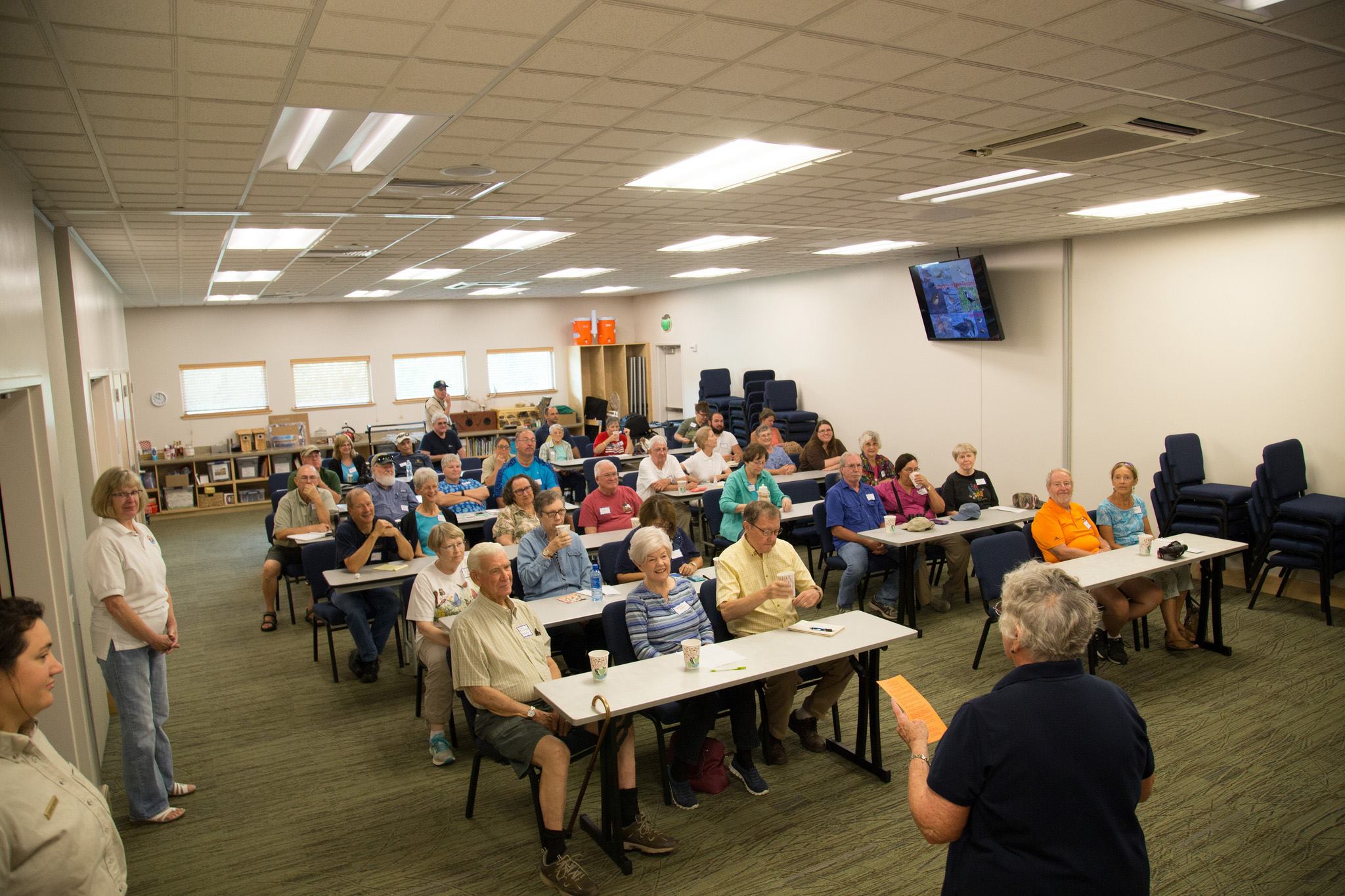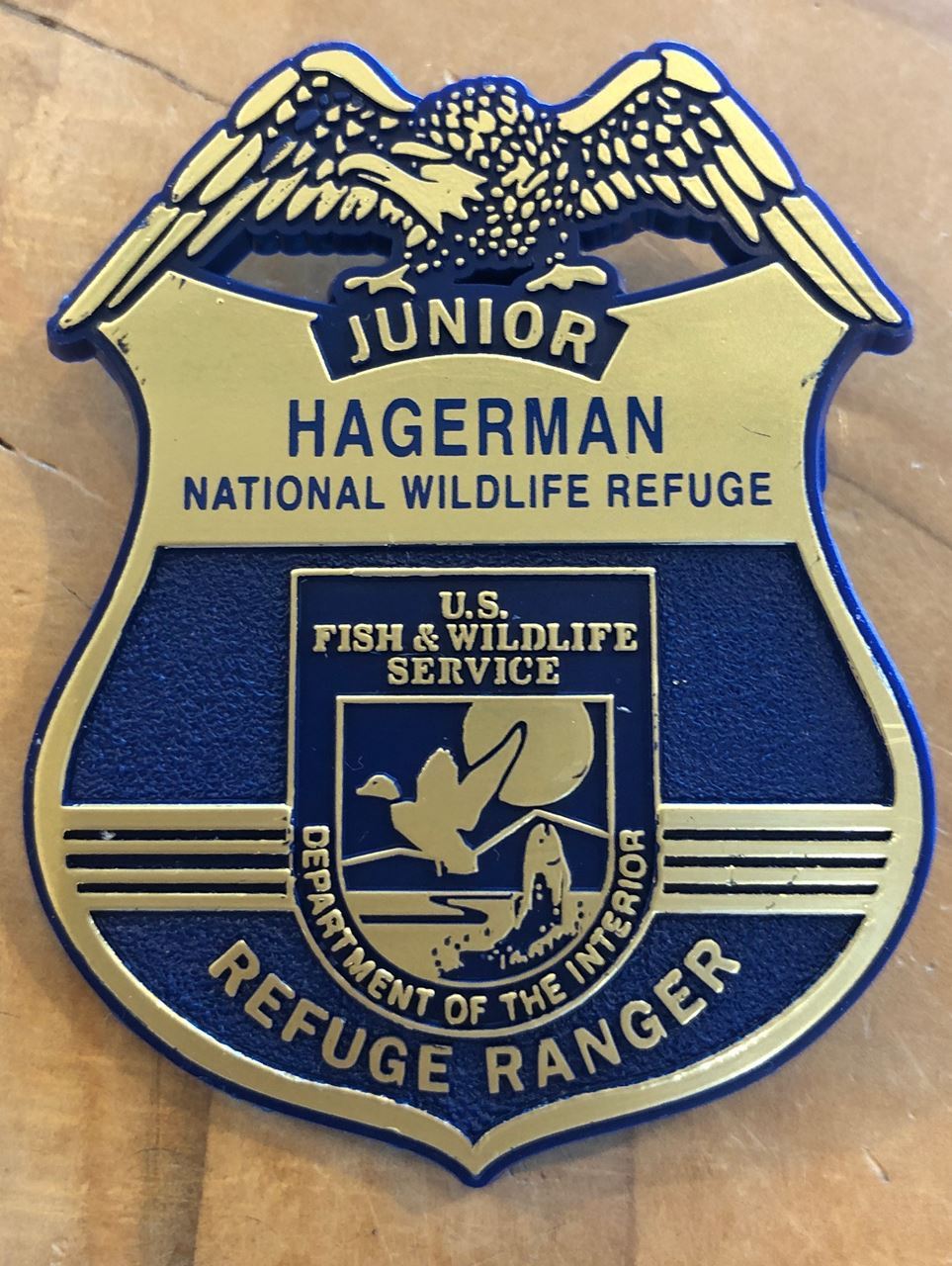Who’s That Playing Peek-A-Boo By Renny Gehman Yellow-bellied Sapsucker by Donnie Simmons Before I could raise my binoculars, the bird slipped around the trunk of my persimmon, then peeked at me from a foot higher up. I knew it wasn’t my usual Hairy Woodpecker, but it was so intent on keeping the tree trunk between us that it took me a few seconds to identify the beautiful Yellow-Bellied Sapsucker. Which got me to thinking how much easier it is to identify woodpeckers in the winter, when they can’t hide among the leaves! |
We are blessed at Hagerman and the surrounding area to have eight woodpeckers on our species checklist—seven of which are simple to spot in the winter if you know where to look. So, before the leaves once again appear to provide our stealthy feathered friends more camouflage, let’s find out more about these interesting and opportunistic birds. On January 21st, the Hagerman NWR Bird Census Team recorded 31 Woodpeckers: 2 Yellow-bellied Sapsucker 2 Red-headed Woodpecker 7 Red-bellied Woodpecker 6 Downy Woodpecker 1 Hairy Woodpecker 13 Northern Flickers
Northern Flickers by Mike Petrick Downy Woodpeckers and Northern Flickers are relatively common: if you keep your eyes peeled along the trails passing through our deciduous trees, you might see either one of these species hunting for insects on tree trunks. While both Red-bellied and Downy Woodpeckers present as mostly black and white, their markings are very different, and they are easy to tell apart by size. |
The Downy is our smallest woodpecker, about 6 inches in length, about 1/3 smaller than the 9-10-inch-long Red-bellied, and is quite easy to recognize with its white back, white spots on black wings and a black-and-white striped face. The male also has a bright red spot on the back side of its neck, while both male and female have white underparts. The Downy is a frequent visitor at suet feeders and can often be found hanging upside down when eating from one. |
The Red-bellied Woodpecker, however, can be extremely hard to identify—if you’re looking for a woodpecker with red on its belly! To quote Birdwatcher’s Digest, the Red-Bellied is “named for its least obvious field mark.” On this familiar, common and vocal woodpecker the most obvious field marking is the bill-to-nape stripe of red down the back of its head which is entire in the males while the female just has a red nape. Coupled with the zebra patterned stripes on its back, the Red-bellied Woodpecker is easy to identify, although it can sometimes be misidentified as a Red-headed Woodpecker by inexperienced observers. |
|
So why is it called a Red-bellied Woodpecker? Well, there is a faint wash of red on the belly between the legs, but this is usually obscured by the tree trunk as the Red-bellied marches up and down a tree searching for beetles or other insects. Since they are tolerant of humans, Red-bellied Woodpeckers are Hagerman’s most sighted woodpecker representative. The next four “uncommon” woodpeckers at Hagerman are harder to find but are still seen regularly. The Yellow-bellied Sapsucker (again, named for a hard to see field marking!) is a migratory visitor to Hagerman, so it’s usually sighted in winter. Named for the neat rows of holes it drills around tree trunks, it feeds on the sap produced along with any insects unlucky enough to be trapped by the sticky flow. Sapsuckers are also mostly black and white, with the male sporting a bright-red forehead and throat. The female also has a red forehead but lacks the red throat. Both sexes have bold white stripes curving from their face to a black shield on their chests. Another easy-to-spot field marking is the bright white stripe along the folded wing. Underparts can shade from white to the “yellow-belly” that earned them their name. Unlike the vocal Red-bellied Woodpecker, Sapsuckers tend to be silent except during breeding season, so they are best identified at Hagerman by their behavior. Look for the rings of holes on trees, especially maples and fruit trees. Another woodpecker which isn’t called a woodpecker is the Northern Flicker. While the Flicker is considered one of the most widespread woodpeckers in the U.S., here at Hagerman they’re uncommon. In December/January, our weekly counts will average about three Flickers per visit—although during one count in 2018 ten Northern Flickers were seen. That is the highest total recorded by eBird for this species at Hagerman. Still, Northern Flickers are simple to identify with their black bibs and spotted bellies. They are also a larger woodpecker at 13 inches, slightly larger than a robin. Males have a red nape and black whisker, while both genders show yellow wing flashes in flight. Scientists have subdivided Flickers into Yellow-Shafted and Red-Shafted varieties, which used to be separate species. The classifications have gone back and forth several times but the variety most often seen here is the Yellow-Shafted, although we officially list it as a Northern Flicker. |
 Red-headed Woodpecker By Mayve Strong | Like the Red-bellied and Downy Woodpeckers, the Red-headed Woodpecker sometimes nests at Hagerman, but is not as often sighted although it is extremely easy to identify. This bird sports a complete red hood—unlike the Mohawk-shaped stripe of the Red-bellied. It also has a solid black back and tail which serve to highlight the bright-white belly and breast and sets off the all-white secondary feathers on the wings. A Red-headed Woodpecker is hard to miss in flight! Look for it in dead trees along Hagerman’s creek bottoms or among the blackjack and post oaks lining many trails. Red-heads have a varied diet of nuts—especially acorns—and are adept at catching insects in flight. They are attracted to feeders filled with cracked corn. Our largest woodpecker—crow-sized and hard to miss—is the Pileated Woodpecker. Again, while uncommon at Hagerman, they can be seen fairly regularly during the winter and can nest on the refuge. Once spotted, however, it is impossible to mistake the Pileated for any other |
woodpecker. Aside from its large size ( ̴ 18”) the Pileated Woodpecker is easily identified by its powerful bill (almost as long as its head), large black body with flaming red crest and cheek stripe (missing in the female) and white stripes on the face which continue down the neck. In flight, the white underside of the wing is distinctive, as are the white bars on the shoulders, although the wings appear black when folded. These woodpeckers love to lap up ants from dead trees and can sometimes be seen tearing up dead stumps to get at the insects.However, they also clamber around on smaller branches to get at the fruit and berries which make up about ¼ of its diet. In addition, they are known to visit feeders for suet and/or seeds. |
Pileated Woodpecker by Donnie Simmons Hairy Woodpecker by Pam Rendall-Bass |  |
While these six species are regularly seen on the refuge, we also have documented sightings of two other woodpecker species (Ladder-backed and Hairy), which means that of the sixteen known species of woodpeckers in North America, at least eight have visited Hagerman. So, it makes sense to keep your eyes peeled the next time you walk one of our winter trails to see who’s peeking at you from behind that tree trunk. You never know—that bird playing hide-and-seek with you could be a new life bird for your list—or a simple reacquaintance with an old friend. |
Photos by Pam Rendall-Bass More Amazing Nature Photos taken at the refuge (Facebook account required.) |
Upcoming Activities:
The Friends of Hagerman is Hosting 5 Family Friendly Events in February! Donate to help fund programs like these! |
|
Countdown to Monarch Spring Migration Learn How You Can Help!
Photo by Laurie Sheppard The days are getting longer and in about two months, the first Monarchs will arrive in north Texas. When they do, volunteers from Friends of Hagerman NWR will be on hand to collect information such as what the butterflies are feeding on and where there is milkweed to support their larvae. Those butterflies may have traveled many thousands of miles to get to this point and survived many hazards to finally begin the next generation. Each year, Friends of Hagerman NWR participates in the Integrated Monarch Monitoring Program (IMMP) - a national program that documents milkweed, nectar plant, and monarch use data from various land-use types and regions. Information gathered at National Wildlife Refuges like Hagerman is an important part of the research shaping scientists' understanding of how monarchs interact with their environment and how the population and its habitat changes over time. The U.S. Fish and Wildlife Service recently proposed listing Monarch butterflies on the Endangered Species List. For more information or to find out how you can join the Monarch Monitoring Team, |
Butterfly Garden Update: The Missing Pergola My how time flies! The Butterfly garden opened in 2014, and when some of the ornamental support pieces fell down, the Outdoor Crew knew we needed to begin watching for more signs of wood rot. Eventually, the support beam of the pergola showed signs of wood rot, so it was time to make a plan to take the structure down. The FOH Board agreed in January to support and fund the replacement of the structure. It was noted that the work was best suited to be done in the winter, in order to prevent as much damage to surrounding plants, when they were dormant. Crossvine was successfully established on each of the corner posts of the structure and was cut-back in order to facilitate taking the structure down. A new pergola made of cedar with the same dimensions of the original design has been selected to replace to old structure. Timeline is to be determined as volunteer labor becomes available. Email the Friends of Hagerman NWR at info@friendsofhagerman.org to inquire about joining the Work Crew. |
Second Saturday: The Role of a Petroleum Specialist with Mary Maddux Saturday, February 8, 2025 at 10:00 AM in the Visitor Center
Learn all about the oil rigs on the refuge, and the ways in which they benefit Hagerman NWR. Photo by Bertazzoni Marco Future Second Saturday Programs |
|
|
|
Join the Butterfly Garden Docents Do you love butterflies and native plants, like to learn new things, enjoy being outdoors and meeting new people, and like helping others learn? Then consider joining the Hagerman Butterfly Garden Docent Program!
For more information contact: Kim Tingle Texas Master Naturalist HNWR Butterfly Garden Docent Program Chair info@friendsofhagerman.org |
Birding with Jack: The Weekly Bird Census Left to Right: Mike Petrick, Nancy Riggs, Jack Chiles and Terry Goode Each Tuesday a team of experienced birders, including Master Naturalist Jack Chiles, traverse 35 miles of refuge roads and hiking trails, documenting every bird they encounter. This Bird Census is reported to The Cornell Lab of Ornithology for use in research, and each week we will bring you a link to their actual bird count, and a summary of their adventures.
Northern Shoveler almost in full breeding plumage, a Wilson’s Snipe dipping into the mud, and a Ross’s Goose backed up by two Snow Geese. It was cloudy all day but dry and winds were light for today’s census. The lake level has dropped significantly since last week and there were plenty of sandbars and shallow water. We started out on Raasch Trail as usual and found sparrow numbers were low. That trend continued all day, although we did get a good variety of species. Harris’s Sparrows were the most common, with 21 counted, but we found at least a few of most other sparrow species, including 5 Vesper Sparrows on Short Road. As we continued on, we came across a large flock of Brown-headed Cowbirds with about 20 Brewer’s Blackbirds mixed in. We found the first of 5 Brown Thrashers before we got to the Goode picnic area. Back on the Auto Tour route, we started seeing large numbers of waterfowl. It’s clear the ducks are happy to be back in ice-free ponds. We saw 227 Northern Pintails, 229 Green-winged Teal, 137 Gadwall, 115 Northern Shovelers, 98 American Coot, and quite a few Buffleheads, Ruddy Ducks, and other assorted ducks. Ring-billed Gulls were also plentiful, especially later in the afternoon, with our final tally being 684 individuals, plus 8 American Herring Gulls. A few Long-billed Dowitchers have returned and Wilson’s Snipes are also working the muddy areas. Out at Sandy Point, we were pleased to find a Bald Eagle on the nest across the bay. We finished our day with 80 species. Photos today are a Northern Shoveler almost in full breeding plumage, a Wilson’s Snipe dipping into the mud, and a Ross’s Goose backed up by two Snow Geese. Watch for the census results every Tuesday evening: Bird Census Results |
Photo Club Workshop: Editing with Lightroom with Nancy Miller February 22, 2025, 10:00 AM – 11:30 AM Join us for the February workshop of the Friends of Hagerman NWR Nature Photography Club. Everyone is welcome to attend -- members and non-members, beginners and experienced. Learn how to edit your photos by using the tools and masks. Even if you don’t use Lightroom, a lot of these basic tools are available in most of the editing software. I will show you ways to possibly save a photo you might throw away. Keep in mind, this does not apply to a photo that is out of focus. If you have a photo you would like me to use as an example, you can email it to me at: n-miller@msn.com, and I will be glad to see what can be done. If you plan to attend this workshop, please register by emailing Nancy Miller at:
For questions about the photo club, contact: Lisa Wilkins, Photo Club Leader Email FOHphotoclub@gmail.com Upcoming Events: |
Nature'Ology: A Fun Day of Learning About Nature! A free single day camp for children 11 or 12 years old Saturday, June 7th, 2025 A full day of learning all about nature: fossils, prairies, spiders, birds, snakes and water cycles! Make a terrarium, enjoy a nature craft and meet other young nature enthusiasts! This program has become so popular, that it fills up very quickly. As a pre-registrant, you will be emailed a link to apply for a confirmed reservation on Wednesday, May 7th at 10:00 AM, one day before reservations become available to the general public. The first 30 students to complete registration on or after May 7th will be granted a confirmed reservation. |
The Refuge Rocks! Scat Tracks & Signs February 15, 2025 at 10:00 AM in the Visitor Center
The wild animals at Hagerman National Wildlife Refuge are rarely seen. So, how do we know they live here? On Saturday, February 15, come out to the refuge to develop your tracking skills by examining and interpreting the indirect evidence animals leave behind. We will be exploring scat and tracks. We’ll learn how to get started identifying tracks, scat, and other animal signs when hiking on our trails. We’d love to see what you find while exploring the outdoors today! Studying what an animal leaves behind is a great way to learn about the lifestyle and habits of local wildlife. Let’s learn about scat, tracks, and signs with a short lesson, some fun games and activities, as well as a fun craft! Come join us on February 15 for a free class for youth ages 5-10. Future events (Registration Required)
|
| Puddles' Craft Corner By Cindy Steele, Master Naturalist |
The Great Backyard Bird Count - 2025
By Cindy Steele
Welcome back to Puddles’ Craft Corner! It is time for the yearly Great Backyard Bird Count! What is that, you ask? The Great Backyard Bird Count (GBBC) is a free, fun, and easy event that engages bird watchers of all ages in counting birds to create a real-time snapshot of bird populations. Participants are asked to count birds for as little as 15 minutes (or as long as they wish) on one or more days of the four-day event and report their sightings online at birdcount.org. Anyone can take part in the Great Backyard Bird Count, from beginning bird watchers to experts and any age bird watchers. The best part is that you can participate from your own backyard, or anywhere in the world.
When is this event held in 2025? The 28th annual GBBC will be held Friday, February 14 through Monday, February 17 2025. This global activity is sponsored by the Cornell Lab of Ornithology, the National Audubon Society, Birds of Canada, and partially by Wild Birds Unlimited. For any additional information, visit the official website at birdcount.org for more information.
Here are ten tips for making the most of the Great Backyard Bird Count this year!
1. Know Why Counting Birds is Valuable.- The Great Backyard Bird Count is a citizen science project which generates data that can be collected by a lone individual or research group. It’s a huge coalition of individuals dedicated to learning more about our feathered friends. Here are a few more tidbits about the Great Backyard Bird Count:
- The Great Backyard Bird Count is sponsored by the Cornell Lab of Ornithology and the National Audubon Society.
- The event is four days long.
- Participants count birds for at least 15 minutes on one or more days of the four-day event.
- Counts are reported to birdcount.org, the go-to site for more information!
2. Count in a Location That’s Comfortable, Easy to Access, and Likely to Have Birds.
You don’t have to travel far to participate. Your very own front or backyard are fabulous places to count birds. It’s fun to gather around the table or the window and watch birds at feeders in the yard! If your backyard doesn’t offer easy access to birds, consider alternatives. Just...
Lesson with Full Instructions and other Nature Crafts with PuddlesJunior Ranger Program
|
| The Junior Ranger Pledge As a Junior Ranger at Hagerman National Wildlife Refuge, I pledge to protect outdoor creatures small, big and huge. To keep the water, air and land clean. To make enjoying nature a routine. I will share my new skills with family and friends. When people and nature work together, everybody wins! |
|
Sponsors Enable the Friends to…
Join Today! Memberships available for $10 |
Come, Take a Tour on the Wildlife Explorer! Come join us for a ride on the Wildlife Explorer! Our new and beautiful tram is available for ninety-minute tours of Hagerman every Saturday and Sunday, weather permitting. Our tours are as varied as our drivers. Each tram driver has her/his approach to the tour: you may learn about wildlife, birds, habitat, refuge history, photography, you name it! To paraphrase, “a Wildlife Explorer tour at Hagerman is like a box of chocolates, you never know what you’re going to get.” But you know it’s going to be good! Come see us! Lots of stops for bird-watching and photography. |
Register for a Tram Tour Today! |
|
|
Photo by Cathy Van Bebber | Sunrise at the Little Sit by Laurie Sheppard |
Meet Jack and the Bird Census Team and learn how to identify the birds of North Texas while enjoying the beautiful sunrise over Lake Texoma! Modeled after Cornell's national "Big Sit" event, a group of dedicated birders invite you to join them at sunrise to conduct a bird count as multiple species fly to the water and the surrounding land to feed. Leaders will bring spotting scopes and will provide tips for identification of the many species you will see. This event lasts a couple of hours, but all are welcome to come and go as they please. Participants are advised to bring a chair, binoculars and water. The First Saturday of every month, beginning 30 minutes before sunrise. |
Location: H Pad, Sadler, Texas 76264 (H Pad is in Sadler, but it is part of the refuge) GPS Coordinates: 33.734961, -96.780582
|
|
Early Bird Walk with Jack Chiles Master Naturalist Jack Chiles will lead our Early Birding event, weather permitting. Bring binoculars or borrow ours. Meet at the Visitor Center and return in time for the Second Saturday program. Please Register (Optional) so we may inform you via email of unforseen changes/cancellations. |
|
Do You Like to Work Outside? The Refuge Needs You! |
It takes a lot of people to have a beautiful garden! The Wednesday Garden Team Love to work with native plants and meet other gardeners? Come and help us add plants, weed and mulch our beautiful butterfly garden. Garden Team volunteers get first dibs on thinned native plants as well as access to seeds and cuttings for propagation. Gardeners meet on most Wednesdays, but times vary. Contact Us to subscribe to the volunteer garden team weekly email. Provide own tools and gloves. Minimum age 18, or 16 if accompanied by parent/volunteer. |
Mowing and Refuge Beautification: The Work Crew Do you enjoy working outside, mowing, sprucing up hiking trails, trimming and removing brush and general cleanup? Show your love for nature by joining the Outdoor Crew at Hagerman National Wildlife Refuge. Outdoor Crew volunteers meet on the First Tuesday and Fourth Saturday of every month. Contact Us for exact times, dates and other details about joining the volunteer Work Crew. Scouts welcome! |
Visitor Center Volunteers Needed! |
Do you enjoy meeting all kinds of people from all over the world, and like-minded people in our area? If yes, consider joining our team of Visitor Center Volunteers. You will greet refuge guests, distribute maps and other refuge information, and make sales in the gift shop. Shifts available every day of the week: Monday through Saturday 9 AM to 12:30 PM and 12:30 to 4:00 PM, Sunday 1:00 to 5:00 PM. Training is provided. Contact Us if interested. |
| Thank You To Our Contributors: Chris Balsamo, Jack Chiles, Cindy Steele, Renny Gehman, Pam Rendall-Bass, Mike Petrick, Laurie Sheppard, Donnie Simmons, Mayve Strong Refuge Manager: Kathy Whaley Deputy Refuge Manager: Paul Balkenbush Visitor Services Manager: Spencer Beard Friends of Hagerman NWR Foundation 6465 Refuge Road, Sherman, TX 75092 Phone: 903-786-2826 Join us on Facebook: |
Search for any word--do not use quotes for phrases |
Kroger: Stop by the customer service desk at Kroger and link your Kroger Card to the Friends of Hagerman: the Friends will get rewards for every dollar you spend, at no cost to you.
Please add info@friendsofhagerman.org to your contacts to ensure delivery of registration confirmations, account information and the Featherless Flyer
See you at the refuge!


 Red-bellied Woodpecker by Donnie Simmons
Red-bellied Woodpecker by Donnie Simmons

















